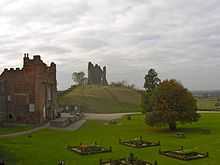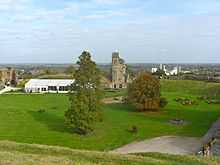Tutbury Castle

Tutbury Castle is a largely ruined medieval castle at Tutbury, Staffordshire, England, in the ownership of the Duchy of Lancaster. It is a Grade I listed building. People who have stayed in the castle include Eleanor of Aquitaine and Mary, Queen of Scots, who was a prisoner here.
Early history

Tutbury Castle became the headquarters of Henry de Ferrers and was the centre of the wapentake of Appletree, which included Duffield Frith. With his wife Bertha, he endowed Tutbury Priory with two manors in about 1080. It would seem that Tutbury at that time was a dependency of the Norman abbey of St Pierre‑sur‑Dives.[1]
The castle was destroyed by Prince Edward in 1264 after the rebellion of Robert de Ferrers, 6th Earl of Derby. In 1269, after a further rebellion the lands were given to Edmund Crouchback and have remained part of the Duchy of Lancaster.[2]
Apart from the 12th century chapel the ruins date from the 14th and 15th centuries when the castle was rebuilt.
In 1999 Lesley Smith became the Curator of the Castle. The Duchy of Lancaster granted her this position for which Smith works as Public Relations Officer.
Mary, Queen of Scots at Tutbury
In June 1568, Mary, Queen of Scots was at Carlisle Castle after fleeing from Scotland after her defeat at the battle of Langside, and the English Privy Council decided to lodge her either at Nottingham Castle, Fotheringhay Castle or Tutbury, so that she was further from the Scottish border or Yorkshire. In January 1569 the Scottish Queen was taken from Bolton Castle, going first to Ripon and staying a night nearby, then to Wetherby staying a night with John Vavasour at Hazlewood Castle, then on to Pontefract, Rotherham, Chesterfield, and Wingfield Manor.[3] George Talbot, Earl of Shrewsbury was given detailed instructions for keeping Mary, which permitted him to lodge her at Sheffield from time to time (which he preferred), and briefed him on what he should say to her regarding her political predicament.

Tapestries, furniture, and bedding were sent from the Royal Wardrobe at the Tower of London to furnish Tutbury, but because of delays caused by poor weather Bess of Hardwick was asked to send her things from Sheffield. This left the Earl's houses at Sheffield unfurnished, so Mary had to go to Tutbury. She arrived on 4 February 1569.[4] She noted the castle was like a hunting lodge, with its enclosure on a slight hill reminiscent of the Bois de Vincennes, and complained of the damp, the wet plaster, and draughty ill-fitting old carpentry.[5] The British Library has a sketch plan of her accommodation at Tutbury.[6]
In March the Earl of Shrewsbury described how Mary sat with Bess, Countess of Shrewsbury in the countess' chamber at Tutbury with Lady Livingston and Mary Seton working at embroidery.[7] She moved to Wingfield Manor in April.[8] Mary was returned to Tutbury in September with increased guard and a reduced household. In November 1569, following the Catholic Rising of the North, Mary was rushed south to Coventry where she stayed in an inn. Elizabeth sent orders for her return to Tutbury on Christmas Eve. The "pauvre prisonniere" (poor prisoner), as she described herself, was back at Tutbury on 2 January 1570.[9] Mary was sent to Chatsworth in May 1570.
In January 1585 she once again returned to Tutbury via Wingfield Manor,[10] and on the way stayed a night in Derby in the house of a widowed Mrs Beaumont. Her keepers Ralph Sadler and John Somer were made busy providing satisfactory hangings for Mary's bedchamber. Hangings brought from Lord Paget's nearby houses at Burton and Beaudesert were unsatisfactory. The queen's bedchamber was located at the top of a lodging (immediately under its roof), which was built against the castle wall. This room was of timber construction, and had no windows looking out through the castle wall, its two windows looked into the castle court.[11]
Mary also had a billiard table.[12] Ralph Sadler sometimes took Mary hunting with his hawks on the river Dove, no farther than three miles from the castle, with a guard of 40 or 50 men on horseback. Queen Elizabeth disapproved of this freedom and forbade it.[13] On 19 April 1585 Mary was placed in the care of Sir Amyas Paulet, who took down Mary's cloth of estate from the chamber where he ate, and stopped Mary's servants using the wall walk near the gate. Paulet also curtailed her charitable activities in the town, and disarmed her Scottish servants, many of whom had pistols.
In July she was allowed to hunt her greyhound after deer at Stockley Park near Anslow. By August Mary was anxious to move temporarily to another house so her lodgings could be swept and cleaned. Mary pointed out that the Earl of Shrewsbury followed this routine. However, Lord Paget's nearby houses and the house of Mr Henry Cavendish (son of William Cavendish) at Doveridge were not suitable to house all her train of servants.[14] Paulet considered modifying her lodging or letting the queen use another part of the part of the castle which he occupied. Security was difficult for this other lodging, where Mary had stayed in 1569. It had two chambers twenty-four feet above ground level, with windows looking over the dykes towards Tutbury town. The windows and a "house of office", a latrine, could have been used for escape.[15] On Christmas Eve 1585, she finally moved to Chartley Castle.[16]
Hauntings
Reported sightings of ghosts include that of a soldier on the ramparts, a white lady in a window of the tower, and Mary, Queen of Scots. A number of visitors to the King's Bedroom reported feeling overcome and faint; the room was closed to the public for a while after these reports, but has since been re-opened. The castle now hosts nocturnal both private and public ghost hunts.[17]
See also
- Castles in Great Britain and Ireland
- List of castles in England
- List of Grade I listed buildings in Staffordshire
References
- ↑ Marios Costambeys, 'Ferrers, Henry de (d. 1093x1 100)’, Oxford Dictionary of National Biography, Oxford University Press, Sept 2004; online edn, May 2007 [ 61, accessed 28 Oct 2007]
- ↑ J. R. Maddicott, Ferrers, Robert de, sixth earl of Derby (c. 1239–1279), Oxford Dictionary of National Biography, Oxford University Press, 2004 [ accessed 28 Oct 2007]
- ↑ Bain, Joesph, ed., Calendar State Papers Scotland, vol. 2 (1900), p.438-9, 543-4, 605
- ↑ Calendar State Papers Scotland, vol.2 (1900), p.606-7, 609-10, 612-4, 615-7
- ↑ Mackie, Charles, Castles, Palaces & Prisons of Mary, Queen of Scots, (1850), pp. 427-8
- ↑ British Library manuscripts blog 24 August 2013, MS Additional 33594, f. 174
- ↑ Calendar State Papers Scotland, vol.2 (1900), p.632-3
- ↑ Fraser , Antonia, Mary, Queen of Scots, Wiedenfield, London (1969), 409-414.
- ↑ Marie Stuart Society Mary, Queen of Scots: England: Calendar State Papers Scotland vol.3 (1903), p.17, 21, 34, 36, 40-41
- ↑ HMC, 12th Report & Appendix, part 4, Duke of Rutland, vol. 1 (1888), 171, Ralph Sadler to John Manners.
- ↑ Calendar State Papers Scotland, vol. 3 (1903), pp.555-558, 583
- ↑ Clifford, Arthur, ed., Sadler State Papers, vol.2 (1809), p.505-7, 511
- ↑ Clifford, Arthur, ed., Sadler State Papers, vol.2 (1809), p.538, 540
- ↑ Morris, John, ed., Letter books of Amias Paulet, (1874), pp. 11-12, 14, 39, 47, 53-54, 61, 63-4, 72-4
- ↑ Letter books of Amias Paulet, (1874), pp. 90-1, 105-6
- ↑ Fraser, Antonia, Mary, Queen of Scots, Wiedenfield, London, (1969), 419, 422, 474, 477, 479.
- ↑ Hauntings of Tutbury Castle
External links
| Wikimedia Commons has media related to Tutbury Castle. |
| ||||||||||||||||||||||||||||||||||
Coordinates: 52°51′34″N 1°41′26″W / 52.859479°N 1.690575°W